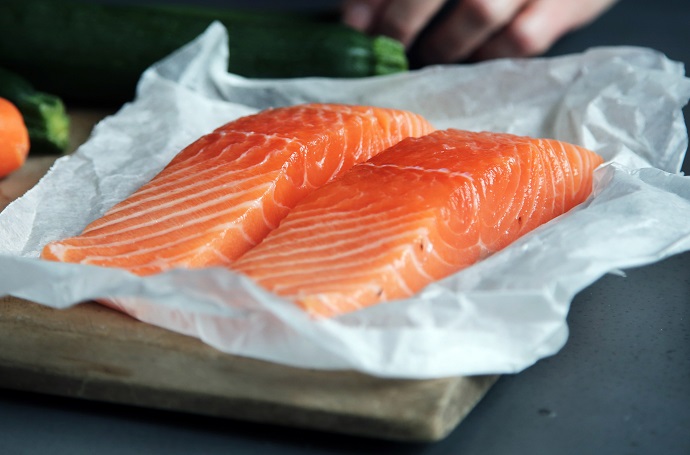Farmed or wild-caught fish? It’s an issue that consumers consider for both health and environmental reasons. Health-wise, you might wonder which has more nutrients. Environmentally, you wonder which is better for fish populations and the oceans. Read on to learn more and find some tips to source fish that’s right for you.
Health Impacts of Fish Consumption
Fish is generally considered nutrient-dense, protein-rich, and relatively low in sodium. Fish and shellfish are the main dietary sources of omega-3 fatty acids EPA and DHA, and of bone-strengthening vitamin D. Some research has shown that fish consumption as part of a healthy diet may help lower the risk of heart disease, stroke, and hypertension.
The USDA currently recommends eating seven ounces of fish per week. This recommendation was established at a level that both maximizes fish’s nutritional benefits while minimizing the possible health risk from mercury, which pregnant women and children are advised to avoid because of its link to neurologic problems. Fish, especially swordfish, king mackerel, shark, and albacore (white) tuna, concentrate mercury in their bodies. It’s best to choose options like salmon, trout, and Atlantic and Pacific mackerel, which are higher in omega-3s, but lower in mercury.
Farmed versus Wild-Caught Fish: Are They Different Nutritionally?
One of the main differences between farmed and wild-caught fish is their diet. Farmed fish are fed a high fat, high protein diet, while wild-caught fish eat a natural diet of krill, plankton, and small organisms like algae. While these differences can have an impact on a fish's nutritional value, it is often a negligible difference. At the end of the day, both types of fish are important sources of omega-3 fatty acids and vitamin D and can be incorporated into a well-rounded diet.
Environmental Impacts of Wild-Caught Fish
Overfishing—or catching fish faster than they can reproduce—leads to a lack of genetic diversity, increased vulnerability to illness, and eventual extinction of the species, as well as a ripple effect in the food chain. If the food chain breaks at any level, all organisms in that chain are impacted. Larger fish, like tuna, are top predators, so when they’re overfished, marine ecosystems suffer even more—smaller marine animals increase in numbers, causing algae overgrowth and eventual threats to coral reefs.
One-fifth of the world’s catch is either illegal, unreported, or unregulated. And some fishing methods, though legal, are inherently damaging, even in moderation. For example, trawls and dredges that drag across the seafloor can destroy habitats used for aquatic animals’ shelter, food, and breeding. They can also directly hurt other species, which are often caught unintentionally in nets. This unintentional capture, or bycatch, accounts for 40% of the world catch—that translates to thousands of sharks, sea turtles, dolphins, whales, and seals needlessly injured or killed each year.
The good news is that there are fishing companies that care about the well-being of the oceans. To find fish that were caught sustainably, look for the Marine Stewardship Council (MSC) blue label. The MSC is the world’s leading certification program for sustainable fisheries. The Monterey Bay Aquarium Seafood Watch provides recommendations and ratings on their website and app to help consumers choose fish that are fished in ways that support healthy oceans.
Environmental Impacts of Farmed Fish (Aquaculture)
The environmental impact of farm fishing can vary depending on species, methods, and location. If good practices are used, fish farming has little impact on the environment. Farmed shellfish, like clams, oysters, scallops, and mussels, typically have few negative environmental impacts. However, most aquaculture requires chemical treatments, which can create the potential for on-farm diseases, and for chemicals to pollute the environment and affect passing wild fish.
To source from environmentally responsible fish farms, check out the Monterey Bay Aquarium Seafood Watch’s recommendations. You can also ask your local fishmonger about his or her sourcing practices. Ideally, he or she would buy from closed, onshore fish farms that source sustainable feed and responsibly dispose of their byproducts. These have the least environmental impact.
Farmed versus Wild-Caught: Which Is Better?
There’s no across-the-board answer to whether farmed or wild-caught fish are more nutritious or easier on the environment. What is clear, however, is that regardless of sourcing, both options provide beneficial nutrition. It’s likely that a consumer’s choice will depend upon budget and resources.
At SAGE, fish is one of many nutrient-dense options we serve our communities—and we love its versatility. Our Recipe Collection includes 178 fish dishes—from Red Curry Fish to Baja Fish Tacos and Smoky Pan-Seared Tilapia. Sourcing sustainably is important to us. We always do our best to abide by the Monterey Aquarium Seafood Watch, and to purchase from local suppliers with practices we’re proud of. We teach our guests about where their fish comes from and how it was farmed or caught—look for signs on the servery with fun and educational facts.







